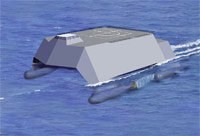University at Buffalo electronic-packaging researcher is helping the U.S. Navy to develop a next generation all-electric warship that will revolutionize the Navy's use of weaponry and manpower.
The electric warship's system architecture to be designed by Cemal Basaran, director of the Electronic Packaging Laboratory in the UB School of Engineering and Applied Sciences, and other researchers working on the project for the Navy will make available throughout the entire ship onboard electric power generated by the ship's power plants and mechanical propulsion system.
Standard shipboard electrical systems currently are unable to distribute this immense electrical power to all parts of the ship, making impractical the use of advanced weapons and sensors that require a lot of power, according to the Navy.
Increased power availability will lead to computerization of most of the electric warship's operations, which will make manpower redundant. The electric warship will require a crew of 100, compared to traditional battleship crew that numbers in the thousands, according to Navy estimates.
The Navy plans to have the electric warship operational by 2012.
Basaran, under a $500,000 Navy grant, will design next-generation power electronics capable of carrying high-current density and high-power to all parts of the warship, using nano and microelectronics technology. This will be a critical component of the ship's system architecture, Basaran says.
"The next-generation power electronics that will control the ship will lead to major improvements in effectiveness, survivability and cost savings, as well as a significant reduction in the size of the vessel's components," he adds.
Basaran and co-researchers in the UB Electronic Packaging Lab are renowned for their pioneering work in designing and testing micro- and nanoscale electronic packaging. Their work, already in use by companies such as Intel, has helped produce smaller, faster and longer-lasting electronic devices at much lower cost. They have developed advanced computer models to simulate and predict electronic packaging fatigue life and reliability under extremely harsh service conditions, such as in a Navy warship.
"Our job is to design and test for the Navy micro- and nanoscale, electronic packages that maintain reliability under extremely harsh conditions resulting from concurrently acting vibrations, high-current density, high-power and high-temperature loads," says Basaran, an associate professor in the Department of Civil, Structural and Environmental Engineering.
"The state-of-the art electronic packaging technology cannot handle the huge electrical power needed by an electric ship's warfare and civilian components in micron and nanoscale packages."
The warship's integrated electric system will reduce significantly size and electrical power consumption presently occurring in traditional Navy ships. By significantly shrinking the size of a ship's power components, the Navy will free up onboard space that can be used for other functions, according to Basaran, a recipient in 1997 of the U.S. Navy Office of Naval Research Young Investigator Award.
"Right now most electrical components are huge and waste too much power, but they don't need to," Basaran says. "We can reduce their size and waste by orders of magnitude, while increasing their ability to handle high current-density and high-power levels in harsh environments, significantly."

 The U.S. Navy all-electric warship, implementing new ship designs and making possible the use of advanced weaponry.
The U.S. Navy all-electric warship, implementing new ship designs and making possible the use of advanced weaponry.